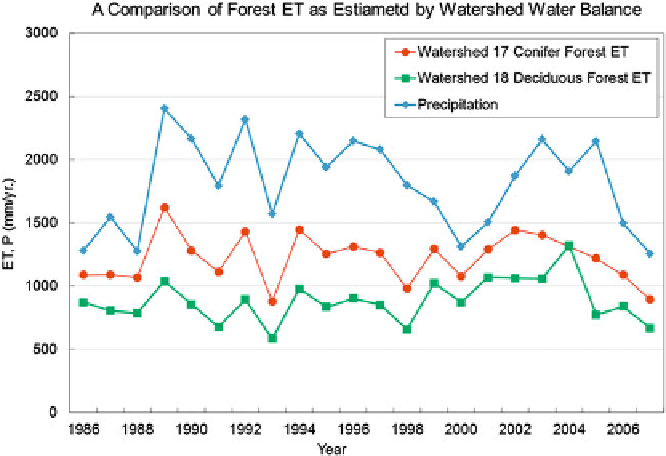Environmental Engineering Reference
In-Depth Information
(Swift and Swank
1981
; Swank and Helvey
1970
). This produced a water yield
increase of 26 cm the first year after the treatment. Clearly, climate regimes had
influences on the hydrologic effects of forest treatments.
15.3.2.4 Tree Species Conversion
Coweeta is one the few sites that have examined the hydrologic responses to tree
species change at the watershed scale (Swank and Douglass
1974
; Komatsu et al.
2007
). Paired watershed experiment studies (Watershed 17 and Watershed 18)
concluded that converting native deciduous forests to white pine plantations has
reduced flow by 20 % in the 17th year after treatment (i.e., planting white pine) in
1956 (Swank and Douglass
1974
) and ET increased by 40 % in the mid-2000s
(Ford et al.
2007
) (Fig.
15.6
). The major reason was that conifers had a higher leaf
areas index (up to 7.1) than the control watershed (Peak LAI for the deciduous
forest less than 6.5), thus higher interception water loss and transpire water year
round (Swank and Douglass
1974
). Seasonally, the largest streamflow differences
between the evergreen forest watershed and the deciduous forest watershed were
found in the dormant winter season.
Fig. 15.6 Paired watershed experiments (Watershed 18 is a control, no management imposed)
show that the watershed dominated by white pine plantations have higher evapotranspiration (ET)
and lower water yield (Q) than the adjacent watershed dominated by native deciduous second
growth forests in the Coweeta Hydrologic Laboratory in North Carolina, USA. All woody
vegetation was cut in Watershed 17 in 1940 and regrowth cut annually thereafter in most years
until 1955; no products removed. White pine trees planted in 1956 and released from hardwood
competition as required with cutting or chemicals

Search WWH ::

Custom Search